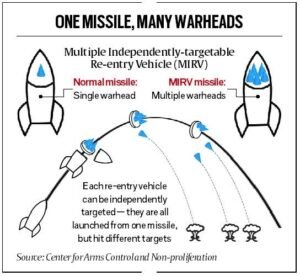
Why in news?
India has joined a small group of countries that use MIRV technology. The Divyastra test indicates that India has mastered the technology for tiny warheads.The successful launch of Mission Divyastra by Prime Minister Narendra Modi marks a significant milestone in India’s nuclear capability. This is the first flight test of the indigenously produced 5,000-kilometer-range Agni-5 nuclear missile, which features Multiple Independently Targetable Re-entry Vehicle (MIRV) technology.It tries to deliver several warheads to separate or the same sites in a single launch. The warheads could include decoys to fool the enemy’s ballistic missile programme.
Advantages of Mission Divyastra for India
- Technological Advancement:
- India’s successful development of MIRV technology through Mission Divyastra marks a significant technological milestone.
- By mastering this technology, India demonstrates its prowess in missile development and strengthens its position as a technologically advanced nation in the field of defense.
- Enhanced Deterrence Capability:
- MIRV-equipped missiles offer a potent deterrent against potential adversaries by significantly increasing the effectiveness of India’s nuclear arsenal.
- The ability to deploy multiple warheads on a single missile enhances India’s deterrence posture by making it more challenging for adversaries to neutralize or intercept incoming missiles, thereby raising the cost of any potential aggression.
- Strategic Parity:
- With the successful development of MIRV technology, India joins a select group of nations, including the US, UK, France, China, and Russia, possessing this capability.
- Achieving parity with major nuclear powers enhances India’s strategic standing on the global stage and ensures its ability to maintain credible deterrence in the face of evolving security challenges.
- Precision Targeting:
- The Agni-5 missile, equipped with indigenous avionics systems and high-accuracy sensor packages, ensures precise delivery of re-entry vehicles to their designated target points.
- This precision targeting capability enhances India’s ability to effectively neutralize enemy assets and enhances the credibility of its nuclear deterrent.
- Securing Future Strategic Needs:
- The successful development of MIRV technology positions India favorably for future strategic requirements.
- While initially intended for Agni-6, the advancement achieved through Mission Divyastra ensures that India is well-prepared to address evolving security challenges and maintain its strategic interests in the long term.
Key Points about MIRV Technology:
- Revolutionizing Payload Concept:
- MIRV technology enables a single ballistic missile to carry multiple warheads, fundamentally altering the concept of missile payloads.
- Origins in the US:
- MIRV technology was first demonstrated by the United States with the successful test of the Minuteman III missile in 1968.The technology was subsequently integrated into operational use in the 1970s.
- Development in the Soviet Union:
- The Soviet Union developed its own MIRV-enabled Intercontinental Ballistic Missile (ICBM) and Submarine-Launched Ballistic Missile (SLBM) technology by the late 1970s.
- Strategic Significance:
- MIRV technology initiated a strategic shift in global nuclear deterrence by enabling nations to inflict greater damage on enemy targets and reduce the effectiveness of missile defense systems.
- Enhanced Targeting Capabilities:
- Warheads on MIRVs can be launched at different speeds and in different directions, allowing for precise targeting of multiple locations.Some MIRVed missiles possess the capability to hit targets as far as 1,500 kilometers apart.
- Complex Technology Requirements:
- Implementing MIRV technology necessitates a delicate balance of large missiles, small warheads, precise guidance systems, and a sophisticated mechanism for releasing warheads sequentially during flight.
- Global Implications:
- The proliferation of MIRV technology among nuclear-armed nations has significant implications for global security and strategic stability, altering the dynamics of nuclear deterrence.
How MIRV Technology Works:
- Trajectory and Deployment:
- MIRV-equipped missiles follow a ballistic trajectory into space, similar to other ballistic missiles.
- Upon reaching suborbital spaceflight, the missile’s upper stage, known as the ‘bus’, aligns itself based on designated targets.
- The ‘bus’ then sequentially deploys multiple warheads, along with decoys and countermeasures, each capable of being assigned a different target or trajectory.
- Re-entry and Targeting:
- After deployment, the warheads re-enter the Earth’s atmosphere and proceed towards their designated targets.
What are the challenges associated with MIRV technology?
- Increased First-Strike Capability:
- MIRV technology enhances a nation’s ability to execute a first strike, complicating the traditional doctrine of mutual assured destruction.
- Broadened Target Spread:
- Multiple warheads from a single missile enable a broader spread of targets, making defense systems less effective and increasing the cost of defense.
- Difficulty in Defense:
- While MIRVs were not initially designed to defeat ballistic missile defenses, they pose significant challenges for defense systems due to their capability to overwhelm defenses with multiple warheads.
- Strategic Implications:
- Possession of MIRV technology not only showcases a nation’s nuclear capabilities but also plays a crucial role in shaping international security and nuclear deterrence strategies.
People also ask
Q1: How does MIRV technology work in ballistic missiles?
Ans: MIRV-equipped missiles follow a ballistic trajectory into space, deploying multiple warheads from a single missile’s upper stage known as the ‘bus’. Each warhead can be assigned different targets or trajectories before re-entering Earth’s atmosphere.
Q2: What challenges does MIRV technology pose for defense systems?
Ans: Despite not being initially designed for this purpose, MIRVs are significantly more difficult to defend against compared to traditional missiles, as they can overwhelm defense systems with multiple warheads and decoys. This broadened target spread complicates the effectiveness of defense strategies and increases defense costs.
Q3: what is mission divyastra?
Ans: India conducted the first flight test of the indigenously developed Agni-5 missile, known as Mission Divyastra. The missile currently features Multiple Independently Targetable Re-entry Vehicle (MIRV) technology. PM Modi complimented the DRDO scientists for successfully executing Mission Divyastra.
Can you be more specific about the content of your article? After reading it, I still have some doubts. Hope you can help me.